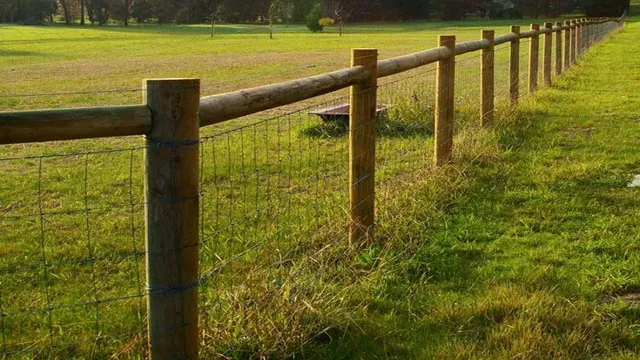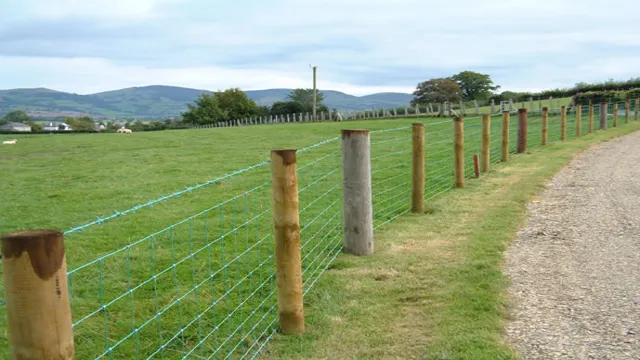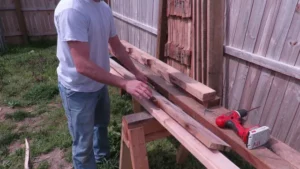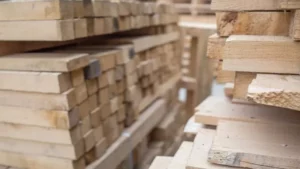Landscape timbers have become a popular choice for DIY fence projects due to their affordability, durability, and versatility. Using landscape timbers as fence posts can bring a rustic charm to your property, as well as being a budget-friendly option to traditional fencing. Not only are they strong and sturdy, but they also make it easy to customize the size and shape of your fence to your specific needs.
In this blog, we’ll explore the benefits and challenges of using landscape timbers as fence posts, as well as tips and tricks to ensure your fence stays upright for years to come. So, let’s dig in!
What Are Landscape Timbers?
Landscape timbers are typically used in landscaping projects to create retaining walls, garden beds, or walkways. They are typically made from pressure-treated wood or composite materials and are designed to withstand weathering and erosion. However, landscape timbers can also be used as fence posts in some cases.
They are often less expensive than traditional fence posts and may work well for smaller fences or those with lighter materials like wire or mesh. However, it’s important to keep in mind that landscape timbers may not be as sturdy as traditional fence posts and may not last as long. It’s always best to consult with a professional before using landscape timbers as fence posts to ensure they are the right choice for your specific project.
Overall, while landscape timbers can be used as fence posts in some cases, it’s important to carefully consider their durability and strength before using them for this purpose.
Definition and Characteristics
Landscape timbers are popularly used in outdoor landscaping projects to enhance the aesthetic appeal of gardens, walkways, and borders. These are long pieces of wood typically measuring around 8 feet in length, 6-8 inches in width, and 3-4 inches in thickness. The wood is pressure-treated, which means it has been treated with chemicals to increase its durability and resistance to decay, insects, and other environmental factors.
Landscape timbers are a great option for gardeners and DIY enthusiasts looking for a cost-effective and easy-to-install solution for defining garden edges, building retaining walls, or creating raised plant boxes. They are versatile and can be cut to size, drilled, or carved according to personal preferences. What’s more, they come in a range of colors and finishes, including natural wood, brown, and black, to match any outdoor décor style.
Whether you’re landscaping a small garden area or a large backyard, landscape timbers are a smart option to consider.

Types of Landscape Timbers
When it comes to landscaping projects, landscape timbers are essential. They are versatile and durable materials that serve both aesthetic and functional purposes. Landscape timbers are wooden planks that come in various sizes, lengths, and finishes, ideal for outdoor use.
These timbers are commonly used for making garden beds, retaining walls, walkways, and edgings. They are also used as borders for sandboxes, play areas, ponds, and landscape features. Landscape timbers can be made from different types of wood, including pine, cedar, and redwood.
The choice of timber will depend on the project location and the desired level of durability. Pine is affordable and easy to work with, while cedar and redwood are naturally decay-resistant and can withstand harsh weather conditions. Overall, landscape timbers provide an easy and cost-effective way to enhance and beautify outdoor spaces, making them a staple for homeowners and landscaping professionals alike.
Can Landscape Timbers Be Used as Fence Posts?
Landscape timbers are often used in landscaping to create garden beds, retaining walls, and other outdoor features. But can you use them as fence posts? The short answer is, it depends. Landscape timbers can be used as fence posts, but they may not be the best choice for all types of fences.
If you’re looking for a cheap and easy option to fence in your garden or yard, landscape timbers might be a good choice. They are readily available at most hardware and home improvement stores, and they are typically less expensive than other fence post options. However, landscape timbers may not be strong enough to support larger or heavier fences, such as those made from wrought iron or chain link.
In addition, they may be more susceptible to rot and decay over time if they are not treated or installed correctly. Ultimately, the decision to use landscape timbers as fence posts will depend on your specific needs and circumstances. If you’re unsure whether landscape timbers are the right choice for your project, it’s a good idea to consult with a professional fence installer or contractor.
Advantages and Disadvantages
Landscape timbers are an affordable and popular option for creating fence posts. They are durable and come in a variety of sizes and styles, making it easy to get the perfect look for your fence. However, it is important to consider both the advantages and disadvantages of using landscape timbers as fence posts.
One of the main advantages is their affordability compared to other materials, making them a great choice for those on a budget. They are also resistant to rot, decay, and pests, making them a durable option that will last for years. On the other hand, landscape timbers are not as strong as other materials and may not be able to withstand heavy winds or pressure.
They also require more maintenance than other options, as they may need to be regularly sealed or painted to protect against weathering. Overall, landscape timbers can be a great choice for fence posts if you are looking for an affordable and durable option but it is important to weigh the pros and cons before making a decision.
Factors to Consider
When it comes to fencing, landscape timbers may seem like a cost-effective option to use as fence posts. However, there are a few factors to consider before deciding to use them. Firstly, landscape timbers are not typically treated with preservatives, so they are not resistant to rot or pests.
This means that they may not last as long in the ground as traditional fence posts. Additionally, landscape timbers are not as strong as metal or wooden fence posts, so they may not be a suitable option for high wind areas or if the fence needs to support heavier weight. Lastly, if you do decide to use landscape timbers as fence posts, be sure to space them closely together to prevent them from warping or bending over time.
Overall, while using landscape timbers as fence posts may seem like a good idea, it is important to take into consideration the potential drawbacks before making a final decision.
Safety Concerns
Using landscape timbers as fence posts may seem like a cost-effective solution, but there are some safety concerns to consider. Landscape timbers are not typically treated for ground contact, which means they can rot and deteriorate quickly over time. This can cause your fence posts to become unstable and potentially collapse, causing damage or injury.
Additionally, landscape timbers are often made from pine or other softwood, which may not be strong enough to support the weight of a fence panel. This could lead to sagging or bowing of your fence, which can decrease the overall effectiveness of your fence’s security. Instead, consider using fence posts specifically designed for outdoor use, which are treated with preservatives to prevent rot and decay.
This will ensure the safety and longevity of your fence for years to come.
How to Install Landscape Timbers as Fence Posts
Yes, landscape timbers can be used as fence posts, but there are some important steps to follow to ensure they are properly installed and will last for years to come. The first step is to choose high-quality landscape timbers that are suitable for ground contact. Next, measure and mark the location for each post, ensuring that they are evenly spaced and level.
Use a post hole digger to create a hole that is at least one-third the length of the timber, and then place the timber in the hole, making sure it is straight and plumb. Fill the hole with gravel or concrete and allow it to set for at least 24 hours before continuing with the fence installation. Repeat this process for each post, and then attach the fence rails to the posts using screws or nails.
Finally, add any desired finishing touches, such as paint or stain, to protect the landscape timbers from the elements. With proper installation and maintenance, landscape timber fence posts can be a beautiful and durable addition to any property.
Steps for Installation
Installing landscape timbers as fence posts can be a great way to add a rustic, natural look to your yard. However, it’s important to take the proper steps in order to ensure that your fence is sturdy and will stand the test of time. The first step is to choose the right type of landscape timbers – pressure-treated is usually the best choice, as it is resistant to rot and insect damage.
Next, you’ll need to dig the post holes at least 2 feet deep – this will help ensure that your fence won’t wobble or fall over in strong winds. Be sure to measure the distance between each post carefully and use a level to make sure that they are all at the same height. Once your post holes are dug, it’s time to install the landscape timbers.
Start by placing a layer of gravel at the bottom of each hole – this will help with drainage and prevent rotting. Then, place the landscape timbers in the hole and backfill the hole with soil. At this point, you’ll want to use a post level to make sure that each post is perfectly plumb.
If any of the posts are leaning, you’ll need to adjust them before proceeding. Finally, you can attach your fence rails to the landscape timbers using bolts or screws. Be sure to use galvanized hardware to prevent rusting.
And that’s it – you now have a beautiful, rustic fence that will add charm and character to your yard for years to come!
Tools and Materials Needed
Installing landscape timbers as fence posts can provide a beautiful and practical solution for delineating your property. But before you start, you’ll need some tools and materials. The most important of these are the landscape timbers themselves, as well as a saw, drill, screws, and sandpaper.
You’ll also need a level, stakes, and string to mark the posts, as well as a shovel, post hole digger, and concrete mix. Once you have everything you need, you can begin the installation process. Start by measuring and marking out the fence line, then dig the holes for the posts.
Next, place the landscape timbers in the holes and use the level to ensure they’re straight. Once they’re set, you can add concrete to secure them in place. After the concrete sets, you can attach the fence panels to the timbers using screws.
With these steps, you can create a beautiful and sturdy fence to help define your outdoor space.
Conclusion
In conclusion, while landscape timbers may have the size and shape of traditional fence posts, they are not designed to withstand the test of time and weather like their sturdier counterparts. Using them as fence posts may result in a quick fix, but in the long run, you may end up with a fence that is more apt to sag and lean than protect and define your property. So, to prevent your fence from becoming a leaning tower of timbers, it’s best to stick with tried and true fence posts that will stand strong for years to come.
“
FAQs
1. Can landscape timbers be used as fence posts? A: Landscape timbers are not typically recommended for use as fence posts due to their tendency to rot and warp over time. It is recommended to use pressure-treated or cedar fence posts for maximum durability and longevity. 2. What type of wood is best for fence posts? A: Pressure-treated pine and cedar are popular options for fence posts due to their resistance to rot and insects. These types of wood are also known for their durability and can last up to 15-20 years if properly maintained. 3. How far apart should fence posts be placed? A: The spacing between fence posts will depend on the type of fence being installed and the terrain of the area. Generally, fence posts are placed 6-8 feet apart for privacy fences and 8-10 feet apart for picket fences. 4. Can I install fence posts without concrete? A: Yes, it is possible to install fence posts without concrete by using alternate methods such as post spikes or tamping gravel around the post. However, concrete is recommended for maximum stability and longevity of the fence. 5. How deep should fence posts be installed? A: Fence posts should be installed at a depth of at least one-third of the total length of the post, with a minimum depth of 2 feet. In areas with extreme weather or soil conditions, posts may need to be installed deeper for added stability. 6. How long should fence posts dry before attaching the fence panels? A: It is recommended to allow fence posts to dry for at least 24-48 hours before attaching fence panels. This will ensure that the posts are secure and have not shifted during the installation process. 7. Can metal posts be used for a wooden fence? A: Yes, metal posts can be used for a wooden fence by using brackets to attach the wooden rails and panels to the post. This method can provide added strength and durability to the fence.






